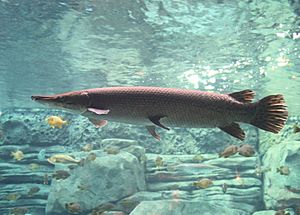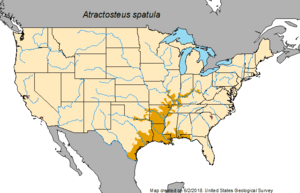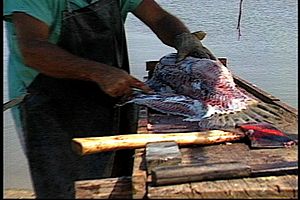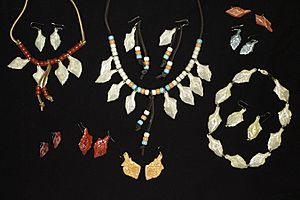Alligator gar facts for kids
Quick facts for kids Alligator gar |
|
|---|---|
 |
|
| Alligator gar in an aquarium | |
| Conservation status | |
| Scientific classification | |
| Genus: |
Atractosteus
|
| Species: |
spatula
|
 |
|
The alligator gar (Atractosteus spatula) is a large fish that lives in freshwater. It is part of the gar family. This fish is one of the biggest freshwater fish in North America. It has been around for a very long time, over 100 million years!
People sometimes call gars "living fossils". This is because they still have some features from their ancient ancestors. For example, they can breathe both air and water. Their name comes from how much they look like an American alligator. They have a wide snout and long, sharp teeth. Some stories say an alligator gar can grow up to 10 feet (3 meters) long.
Alligator gars have a body shaped like a torpedo. They are usually brown or olive on top. Their belly is lighter, gray or yellow. Their scales are very special. They are called ganoid scales. These scales are like bone and are very tough. They protect the gar from other animals trying to eat them. Unlike other gars, the alligator gar has two rows of large, sharp teeth on its upper jaw. They use these teeth to catch and hold their food. Alligator gars are predators that wait quietly and then attack. They mostly eat other fish. But they also eat water fowl and small mammals they find floating on the water.
In the past, many alligator gars were lost from their natural homes. This happened because their homes were destroyed. Also, people hunted them without limits. Now, most alligator gars live in the southern United States and Mexico. They can live in many different types of water. This includes freshwater lakes and swamps. They can also live in salty brackish marshes and estuaries near the Gulf of Mexico.
For a long time, alligator gars were seen as "trash fish." People thought they were bad for fishing. So, governments tried to get rid of them. But in the 1980s, people started to understand nature better. They realized that alligator gars are important for a healthy ecosystem. Now, alligator gars have some protection. Many groups are watching their numbers in the wild. They also teach people about these amazing fish. Some alligator gars are raised in special ponds. This is for research or to help their numbers grow.
Contents
Appearance and Size
Alligator gars are the biggest fish in the gar family. They are also among the largest freshwater fish in North America. Adult alligator gars are often about 6 feet (1.8 meters) long. They can weigh over 100 pounds (45 kg). Some stories say they can grow up to 10 feet (3 meters) long. They might even weigh as much as 350 pounds (159 kg).
The biggest alligator gar ever officially recorded was caught by accident. Fisherman Kenny Williams found it on February 14, 2011. He was fishing in Lake Chotard, Mississippi. The gar was 8 feet 5 inches (2.57 meters) long. It weighed 327 pounds (148 kg). Its body was 47 inches (119 cm) around. Experts think this fish was between 50 and 70 years old. Some even thought it was at least 95 years old. Williams gave the fish to the Mississippi Museum of Natural Science. You can see it on display there.
All gars have bodies shaped like torpedoes. But alligator gars have special features. These include their huge size and heavy bodies. They have wide heads and short, broad snouts. They also have large, sharp teeth. And they have a double row of teeth on their upper jaws. They are usually brown or olive on top. Their underside is a lighter gray or yellow. Their dorsal and anal fins are near the back of their bodies. Their tail fin is not symmetrical.
How They Work
Alligator gars have gills, like most fish. But they also have a special swim bladder that works like a lung. This helps them float. It also lets them breathe air. This is why they can live in water where other fish would not survive. The swim bladder is connected to their throat. This lets them gulp air when they come to the surface. You can often see them doing this in southern U.S. lakes during hot summers.
The scales of alligator gars are very unique. Most fish have flexible scales. But alligator gars have tough, bony scales. They are shaped like diamonds. They often have jagged edges. These scales have a hard outer layer. This layer is like tooth enamel. It makes their scales almost impossible to break through.
History and Family Tree
A scientist named Lacépède first described the alligator gar in 1803. Its scientific name is Atractosteus spatula. Gars like the alligator gar have been around for over 100 million years. Even though they are very old, alligator gars are called "primitive fishes" or "living fossils." This is because they still have many features from their ancient ancestors. These include a special intestine like sharks. They also have a unique tail and their air-breathing swim bladder.
What They Eat and How They Hunt
Alligator gars seem slow and calm. But they are fierce predators that wait to attack. They hunt mostly at night. They mainly eat fish. But they also eat water fowl, turtles, and small mammals. They catch anything floating on the water's surface. They hunt by floating a few feet below the water. They wait for an animal to swim close. Then, they lunge forward. They grab their prey with a quick sweep. Their double rows of sharp teeth hold the prey tightly.
Studies of their diet show that alligator gars eat what they can find. They sometimes eat sport fish. But mostly, they eat smaller fish like gizzard shad. They also eat small creatures without backbones and water fowl. Sometimes, they even have fishing gear or boat parts in their stomachs!
Life Cycle and Reproduction
Like many old species, alligator gars live a long time. They also become ready to have babies later in life. Most female gars do not lay eggs until they are over ten years old. Males are ready in about half that time. For them to lay eggs, the conditions must be just right.
Spawning starts in the spring. Days get longer and water gets warmer. But floods are also needed. When rivers flood, they create new ponds and wet areas. These areas have lots of plants. This gives young fish a safe place to grow. When the water temperature is between 68 and 82 degrees Fahrenheit (20-28 Celsius), gars move into grassy, shallow areas to lay eggs.
During spawning, male gars gather around a female. They twist and bump into her. This makes her release her eggs. Males then release a cloudy liquid called milt. This fertilizes the eggs as they float in the water. The eggs are sticky. They attach to underwater plants. In just a few days, the eggs hatch into tiny fish. After about 10 more days, these young fish swim away from the plants. They start to move around as small fry. A female can lay about 150,000 eggs at one time. The eggs of alligator gar are bright red. They are poisonous to humans if eaten.
Where They Live
Natural Home
Alligator gars live in many types of water. Most are found in the Southern United States. They live in lakes and reservoirs. They also live in the calm waters of rivers. And they are found in the salty waters of estuaries and bays. They live along the Gulf Coast of Texas down into Mexico. They have even been seen in the Gulf of Mexico itself.
In Texas and Louisiana, you can often see large gars breaking the water's surface. They are found throughout the lower Mississippi River Valley. This includes states like Texas, Oklahoma, Louisiana, Mississippi, Alabama, and Florida. In the past, alligator gars were common much farther north. But now, it is rare to see them there. The farthest north a gar was confirmed was in Meredosia, Illinois, in 1922. In 2016, people tried to bring alligator gars back to areas between Tennessee and Illinois. This was to help control invasive Asian carp.
Outside Their Natural Home
Some alligator gars have been seen outside North America. In 2008, a large gar was caught in the Caspian Sea in Turkmenistan. It was thought to be an alligator gar.
In 2009, several alligator gars were found in public parks in Hong Kong. People thought they were put there by aquarium owners. Some local newspapers called them "horrible man-eating fish." This caused fear. So, officials removed all the gars from the ponds. Alligator gars look scary with their teeth. But there are no confirmed reports of them attacking humans.
Other alligator gars have been found in places like Singapore and India. These are usually from people releasing them from aquariums. In 2020, an alligator gar was found dead in a dam in North Cyprus. Experts think it was recently released and could not survive.
How People Use Alligator Gars
Early Uses
Long ago, Native Americans used alligator gar scales. They made arrowheads and armor from them. Early settlers used their tough skins to make leather. This leather was used for things like covering plows and making purses. Gar oil was also used to keep away insects.
For many years, people thought alligator gars were "trash fish." They believed gars harmed other fish. They also thought gars attacked people, which was not true. Fishermen killed many gars, thinking they were helping. But in 1992, a TV show helped change this idea. It showed the life of the alligator gar. This helped people understand that gars are important. Later, states started to protect and manage alligator gar populations.
Sport Fishing
People's views on alligator gars have changed a lot. Now, they are popular as a sport fish. This is partly because of TV shows. States like Texas, Oklahoma, and Louisiana allow fishing for alligator gars. Texas has good gar fishing. They limit catches to one gar per day. The world record for an alligator gar caught with a rod and reel is 279 pounds (127 kg). It was caught in Texas in 1951. Alligator gars are also popular for bowfishing. This is because they are big and put up a good fight.
Business and Farming
Because their numbers went down, wild alligator gars are now watched closely. Their meat is white and tasty. People in the southern U.S. enjoy fried gar balls and grilled fillets. There is also a small business that makes jewelry from gar scales. Some people even make leather from their hides for lampshades and purses.
Alligator gars are good for fish farming. They grow fast and are strong against diseases. They can also live in water that is not perfect. And since they can breathe air, expensive air systems are not needed. This makes them good for farming, especially in developing countries.
Aquariums
Even though alligator gars get very big, some people keep them as aquarium fish. But they need a huge tank or pond to be healthy. They are also popular in public aquariums and zoos. In many places, it is against the rules to keep them as pets. But they sometimes show up in fish stores. Alligator gars are very wanted by private collectors, especially in Japan. Some reports say a large alligator gar could sell for as much as US$40,000.
In 2011, some people were caught trying to illegally send wild alligator gars from Texas to Japan. They were breaking rules about transporting fish. This shows how much some collectors want these unique fish.
See also
 In Spanish: Catán para niños
In Spanish: Catán para niños












